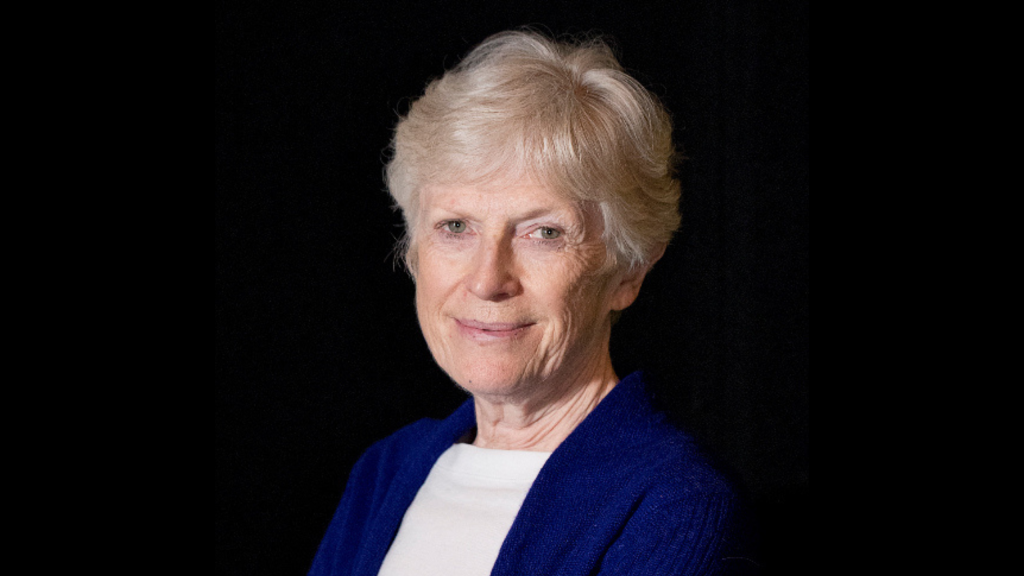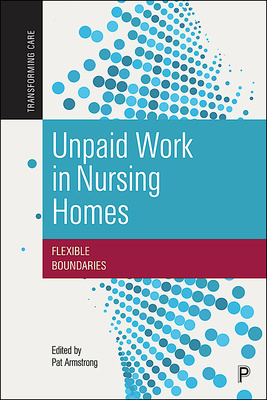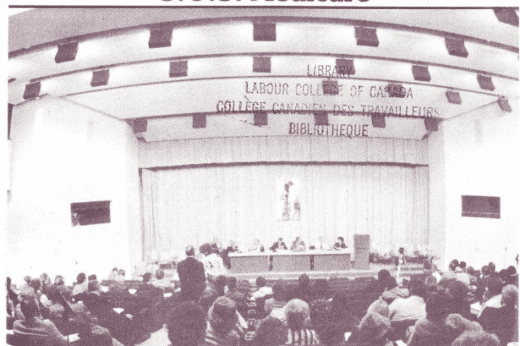“The conditions of work are the conditions of care,” says Pat Armstrong
Counted among the public health care rock stars in Canada is Pat Armstrong. Having educated numerous publicly-engaged health scholars, the Professor Emerita continues her work, publishing books and delivering public lectures. She is the recipient of well-deserved accolades like the Research Canada Leadership in Advocacy Award for her outstanding commitment to patient advocacy and the advancement of health care research.
Armstrong serves on the board of the Canadian Health Coalition and is the co-author or editor of an impressive number of books on health care. Armstrong’s latest book, Unpaid Work in Nursing Homes: Flexible Boundaries (Policy Press, 2023), follows unpaid labourers in long-term care homes in Canada and five other countries.
Her other books include Exposing Privatization: Women and Health Care Reform in Canada; Caring For/Caring About: Women, Home Care and Unpaid Caregiving; Heal Thyself: Managing Health Care Reform; and Wasting Away: The Undermining of Canadian Health Care.
Farhiya Mohamed recently completed a Policy Youth Fellowship at the Canadian Health Coalition through the Urban Alliance for Race Relations. Before heading off to York University to start her Masters degree related to health policy, Mohamed had the opportunity to interview celebrated York University professor Pat Armstrong about care work in Canada.
Your research has included a wide range of topics within sociology, including gender, work, health care and labour relations. Could you elaborate on the overarching themes that have guided your work and the connections you’ve identified between these fields?
Armstrong: I should first make it clear that virtually all my work has been collective and most of it has been done in partnership with student organizations, unions, community groups and sometimes governments. Given that I think of my work as collective, my response to your question is mainly about our work, which includes many different “ours.”
At the University of Toronto in the 1960s, the first year of the honours program in social sciences and humanities required students to take a broad range of courses, providing connections among politics, economics, psychology, sociology, and history. In second year, sociology was the only program that continued to offer such a range of related courses, providing the basis for the political economy that guides all our work.
It was these kinds of connections that were basic to our student politics of the time, connections that provided a framework for our efforts around social justice and equity in general and in particular around access, governance, and women’s issues. At the same time, we helped organize the first union on the University of Toronto campus –a strategy that took the work beyond the campus and into labour relations.
Providing evidence for action was central to the work we did in the various student organizations that employed me, especially evidence that filled the gap in research on Canada. The then new Canadian Studies program at Carleton University provided a place to continue this kind of research.
My Masters thesis, published as our 1978 book, The Double Ghetto: Canadian Women and Their Segregated Work, set out many of the major themes found in our work since then. Political economy framed the analysis, with history, context and evidence understood as critical to understanding the structures, political forces, and ideas that shaped the inequities in women’s paid and unpaid work.
It was women’s work, as well as our daughter’s broken leg, that took us to health care, where one in five women with paid jobs work, and at least as many women do unpaid care work. We quickly learned how much we needed to know about the specific political economy of health and care, recognizing how much context and structures matter. We began with hospitals, moved along with others to home-care and more recently to long-term care, attending especially to ownership and access as well as to the conditions of work and care. And of course, always concerned with equity and gender.

In your extensive research on caregiving and health care, you discussed the challenges faced by caregivers, specifically women. How do you believe your findings impact both policy-making and societal perceptions of caregiving roles? Your research often dives into the experiences of marginalized and vulnerable populations, bringing awareness to their situation. Could you discuss a specific instance where your work has led to policy changes or practical improvements that directly benefited the communities.
Armstrong: The impact of most research is hard to determine. It seldom stands alone. So much depends on the context and partners in the work, on who and what is involved. For example, our research on women’s work in health care had an impact on pay equity but it did so because so many others were struggling over these issues and demanding change. The research done by Women and Health Care Reform, a group I chaired for over a decade, resulted in a special section on gender in Postl’s federal report on wait times. Our booklet–available without charge electronically or in hard copy–on a variety of topics from homecare to disaster responses were used as a model by the Pan American Health Organization, among others. Our funding for the group came from the federal government, which gave us some access to decision-makers, and our years of work together gave us the evidence and analysis to respond quickly to the issues as they arose.
Our research on long-term care has had an impact during the pandemic because so much attention has been focused on the disaster there, and because the research was done in partnership with unions and an employer group that used it to back their demands. The Canadian Centre for Policy Alternatives has published much of our work, making it accessible for use by a broad range of groups. And the health coalitions have also shared our work widely. I often think of Bob White, the union leader who said it is not simply the power of your argument but also the power behind your argument that counts.
Specifically in women’s caregiving, the evidence gathered to make caregiving visible and the skills, efforts, responsibility and working conditions valued has been critical to major gains for women but we were not alone in doing this work. All of it has been important to getting the unpaid care work counted in Statistics Canada and in getting some financial support for those doing this work. It has also been central in major pay gains for health care workers, including midwives and many of the lowest paid women. I have used it in expert reports for these cases, but so have many others. And it is the voices of those who actually do the work –many of them the most marginalized – who provide the evidence base for this research.
Your quote, “the conditions of work are the conditions of care” is often quoted, even by the Prime Minister. Can you please explain it?
Armstrong: It is pretty simple, really, which is perhaps why it has caught on. It was to some extent a response to a growing focus on patients and residents that left out the people who provide care. Without appropriate conditions, it is very difficult to provide appropriate care, however, committed the worker. The conditions also shape what kinds of care are provided by whom, how many and with what skills. The right to provide quality care and to receive such care depends on the conditions under which the care is provided. Hence the conditions of work are the conditions of care.
A main focus of your research has been about Canada’s health care system, uncovering issues related to privatization, aging populations, and the experiences of health care workers. Could you share your thoughts on the most pressing challenges facing the Canadian healthcare system today, and potential areas for addressing these challenges?
Armstrong: There are so many. But one critical challenge is ensuring that we all understand health care as a shared right and a collective responsibility. We need to celebrate what works and works well and the opportunities for innovation in a public system. Doing so also means combatting the profiteers.
There are two major strategies used by those seeking to undermine public care, a group that includes many politicians, corporations, and some professionals. First, they keep saying the public system doesn’t work — pointing to multiple failures- even while they are introducing strategies that make it harder for the public system to work. Second, they then argue that we have to hand over more of health care to the “private sector” so they fix it through their innovative and efficient approaches. In doing so, they claim that much of the system is already private, assuming that making more of it private is no problem. Yet they are blurring the lines between private provisions and public payment. They are also the lines between private practices that draw no profit and those that do, and between non-profit and profit owners, ignoring the evidence on for-profit care. It is not only privatization but also profitization we need to struggle against.
A woman’s work is never done.
Tracy Glynn is the National Director of Projects and Operations for the Canadian Health Coalition



